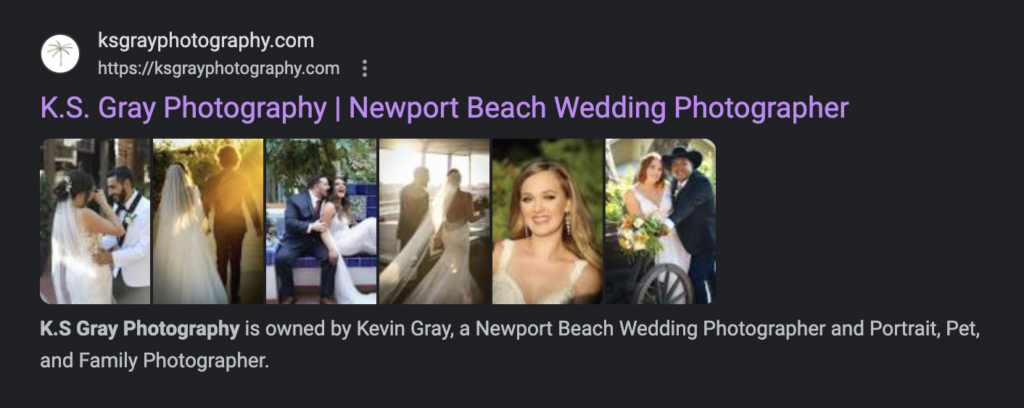
SEO for a Wedding Photographer’s website is perhaps one of the most important things your marketing needs.
SEO for wedding photographers is especially important because it helps put you on the digital map, which is where many of your ideal clients are looking.
Now if you’re new to all of this, let’s start with defining SEO (just in case). SEO stands for Search Engine Optimization and is the driving force behind your website’s visibility on search engines like Google.
When your SEO is optimized, it can help you reach potential clients who are the right fit for you, your work, and your services. When done right, you’ll attract clients who find you on Google and are ready to work with you because they’re a good match for your style, process, and pricing.

Without SEO, your wedding photography website is basically a billboard in the middle of the forest.
I used that same term on a recent podcast recording with Ingvild Kolnes. (I’ll share that once it’s out!) It’s easy to focus on creating a beautiful website, and a lot of wedding photographers do this well! But, your website also needs to work for you.
Here at Emily Foster Creative, my specialty is branding and website design, but I always set up on-page SEO for my clients, because I know the importance of SEO of wedding photography and other creative service provider websites.
A Pro SEO Tip From a Designer
Always ask your potential designers what they include in their packages. Like really, please don’t skip this part as it can set you back months if you and your web designer ignore this.
Unfortunately, I see a lot of websites that have been designed by professional designers but are lacking Page Titles and Meta descriptions. When you are talking to brand and website designers to begin a website redesign, be sure to ask them if they include any SEO services and what they include. Page Titles and Meta descriptions are a couple of the bare minimum on-page SEO details that I personally believe every website designer should include in their packages. If you want some more clarity, my friend Sara Dunn from Sara Does SEO has a great blog post on 5 Questions To Ask Your Web Designer About SEO – read that here.

These are the building blocks for a thriving website and a good reputation on Google as a wedding photographer.
Here are 10 things you can do to improve your SEO for your wedding photographer website:
1. Keyword research:
Keyword research is the cornerstone of effective SEO for your wedding photography business. Before you start optimizing your website, it’s crucial to identify the keywords and phrases that your target audience is using to search for your products or services. This research enables you to align your content with the right terms, increasing the chances of appearing in relevant search results. Utilize tools like Ask The Public, Ubersuggest, SEMrush, or Ahrefs to uncover high-volume and low-competition keywords that can drive organic traffic to your website. You can even use Pinterest in the early stages to see what your ideal clients might be researching!
You’ll want to use your keyword(s) to tell Google “Hey, look over here! I’m a wedding photographer in the Austin area and I serve LGBTQIA+ couples!”. The part where your research comes into play is choosing how to order the search terms. You may find that “Austin Wedding Photographer” is way too competitive to show up on Google in a significant way however, “Wedding Photographer in Austin” may have less competition and a greater chance of listing your page higher on the search engine. Or, you can go even deeper and try to rank for something like “LGBTQIA+ friendly wedding photographer in Austin”.
Of course, when you’re writing copywriting and blog posts for your website, you’ll want to write in a way that sounds natural. Keyword stuffing is when people intentionally stuff their website with keywords like those mentioned above, not using them in a natural way that provides real value to their readers.
2. Page Titles:
Page titles, also known as title tags, are crucial for your on-page SEO as a wedding photographer. For reference, these headlines will appear in search engine results and browser tabs, like the below screenshot that shows an example of one of our wedding photographer clients.
Each page on your website should have a unique and descriptive title that incorporates relevant keywords from the keyword research you’ve done. A well-optimized page title tag not only informs search engines about the content of your page and entices users to click through to your website by offering a clear value proposition. As a wedding photographer, this is your power! The ultimate goal is for you to show up on page 1 of Google, but once you’re there, the wording of your page titles will help your website stand out from the other top ranking websites.
3. Meta descriptions:
Meta descriptions are the brief snippets that appear below the page titles in search results. While not a direct ranking factor, they play a vital role in enticing users to click on your link. Much like your Page Titles, they will capture the eyes of your ideal clients.
The goal is to craft engaging and informative meta descriptions that accurately summarize the content of your page while incorporating relevant keywords. A compelling meta description can significantly improve your click-through rates and indirectly impact your SEO performance.
4. Google Search Console:
Google Search Console is an invaluable tool that provides insights into how your website appears in Google search results. It offers data on search queries, click-through rates, ranking keywords, and your website’s indexing status.
You can also identify indexing issues, monitor your site’s mobile usability and Core Web Vitals (which essentially describes the quality of the user experience on your website), and submit sitemaps for Google to crawl.
This may all seem overwhelming but Google Search Console is absolutely worth your time on this SEO journey. How? By regularly reviewing Search Console data, you can better optimize your content and identify opportunities for enhancing your website’s visibility. Worth it? I think so!
When you work with us at Emily Foster Creative, I will set you up with both Google Search Console and Google Analytics, so that we can monitor your website’s success over time.
5. Google Analytics
Google Analytics offers a wealth of data to understand the user behavior on your website. Seriously, I’ve been on client screenshare calls where I show them their stats, and they are amazed. I even had one client take her budget from The Knot and invest more in her website because she realized how little traffic she was getting from The Knot in comparison to Google (no hate to The Knot!).
Google Analytics provides metrics such as page views, bounce rates, average session duration, and more. By analyzing this data, you can identify your most popular pages, the sources of your website traffic, and the paths users take through your site. This insight helps you refine your content strategy, improve user experience, and make informed decisions to boost engagement and conversions.
I personally think this is one of the most important elements of SEO for wedding photographers, because it tells you where you should focus your time, energy, and money. When you can see the stats that Pinterest is actually sending more traffic to your website than Instagram, you might make the decision to spend more time on pinning your work to Pinterest, or even spend money on a Pinterest manager. (P.S. Julia Bocchese with Julia Renee Consulting has great advice on Pinterest if you ever want to check her out!)
This is especially useful if you are looking for the best ways to elevate your website with someone like me. When I have a client inquire and they tell me that they’re getting traffic from Google, I like to ask for access to their Google Analytics or do a quick website audit through UberSuggest to see where they’re at with their SEO, and what could be impacted by a website redesign.
6. Google Business Profile
For businesses with a physical location, a Google Business Profile is absolutely essential. But for any business, this is going to be one of your website’s most powerful tools! As you wrap up weddings, you can share your Google reviews link with clients and collect vital client testimonials over time.
I recommend you check on your Google Business Profile frequently to ensure that it is fully optimized with accurate contact information, business hours, and customer reviews. You’ll also want to start posting photos on a regular basis and interact with any negative reviews you may receive (but that topic is for a different blog).
Having a robust Google Business Profile not only boosts your local search visibility but also establishes credibility and trust among potential customers searching for your services in your area.
7. URL slugs:
URL slugs are the web addresses that lead to your individual pages (such as www.emilyfostercreative.com/blog). Keep your slugs concise, meaningful, and reflective of your page’s content. Avoid using random strings of characters or excessive symbols.
Instead, use relevant keywords that give users an idea of what to expect when they click on the link. Clean and descriptive URLs improve the user experience and contribute to search engine understanding and ranking.
URL slugs are perhaps one of the simplest but often messed-up part of SEO when it comes to website redesigns. Many website designers forget to set up URL redirects when a domain is changed, and it can really impact your website traffic. It especially has an impact if you’re getting a lot of backlinks. You could be generating tons of traffic from vendor partners’ blog posts, vendor lists, publications, or any other collaborations that you’ve made.
As a wedding photographer, these backlinks are one of your biggest advantages, which leads me to a sneaky little 7.5 tip:
7.5. Backlinks! Backlinks are basically links that exist on someone else’s website but are directed to your website. In this blog post about the Best Podcasts for Wedding Pros, I linked out to some podcast recommendations. That’s called an outbound link when it’s on my website. It’s also an inbound link, or a backlink, on the podcast hosts’ websites. On the opposite side of that, I am getting some backlinks from some of these podcast hosts’ websites and blogs because they are linking out to my website.
Like I mentioned earlier, backlinks are one of the best bonuses of being a wedding photographer because they are so easy to get. Any time you share your work with vendor partners – wedding planners, wedding venues, florists, bakers, etc., they should give you credit. Bare minimum, you can ask to be linked in their Photo Credits page. When I work with planners, florists, etc., I really encourage them to have a page like this photo credit page on Venue at the Edge’s website.
8. User-friendly design:
User experience is a vital component of SEO and is one of the primary areas where my branding website design services come in. A user-friendly website design ensures that visitors can easily navigate and interact with your content.
I mentioned branding services because branding actually plays a huge part in your user experience. Prioritize responsive design to accommodate various devices and screen sizes. I recommend keeping your layout intuitive and clutter-free, making it easy for users to find the information they’re seeking. A positive user experience leads to longer sessions, lower bounce rates, and improved search engine rankings.
9. Heading tags:
When you were selecting your font sizes and styles for your website, did you know the headings were more than just different-sized titles?
Heading tags (H1, H2, H3, etc.) actually structure your content hierarchically, guiding both users and search engines through the organization of your page. These tags are really, really important to website visitors who are using a screen reader. And, unfortunately, they’re something that a lot of website designers forget to handle when working on a website design.
Use H1 tags for your main page title and subsequent heading tags (H2, H3, H4) for subheadings and sections. You should incorporate relevant keywords naturally within your headings to provide context and improve SEO. It’s been found that properly structured headings enhance readability and help search engines understand the content’s importance. Boom! An easy SEO boost right there!
Last but not least, here’s what to do about alllll those images on your website!
10. Optimized images:
Last but not least, images. I saved this one for last because as a wedding photographer, this is perhaps your most powerful SEO tool.
There are two key details to remember when optimizing your website images: 1) compress those bad boys! and 2) alt text and image titles.
For compressing website images, the key is for your images to be large enough to still represent your high quality work, while being compressed to a small size that won’t slow down your website speed. Sites like redketchup.io and tinypng.com are fantastic for this! I’ve also used Lightroom because I can optimize the size of images and the image titles at the same time. However, not everyone has Photoshop or Lightroom, so the alternatives can be great free tools.
You should optimize images by compressing their file sizes without compromising quality. Ideally, images should be compressed to no larger than 500k. Sometimes I’ll go a little higher if a client has a big image across the top of their website (what we call the “hero image” in website speak).
Using alt text and images titles on your images:
The next component of your image optimization is alt text and image titles. If you’ve ever searched an image on Google, like “cute dog” and saved the image to your computer, you may have noticed that it is saved with a specific title. That title is one of the ways that Google was able to filter the image of the cute dog into your search. As a wedding photographer, this is a POWERFUL tool for you.
You’ll want to use descriptive alt text to provide context to search engines, making your images accessible to both users and web crawlers. Whether you’re on your website or social media, alt text is always a good idea. I even include alt text in images on clients’ email newsletters, when I support them with email design.
Finally, your SEO will see an improvement with the use of fast-loading images. Our attention spans are not that long anymore so it’s crucial to capture your audience’s attention before they move on. Faster loading times will improve the overall user experience and contribute to faster page load times, which is a ranking factor for search engines. You can take a look at your website speed by going to PageSpeed Insights.
Whew, that was a lot but we did it! This may all seem overwhelming at first but if you take time to tackle each step, it will be well worth it in the long run.
TL; DR. Why is SEO for my wedding photography business important?
Each SEO detail plays a significant role in improving your website’s overall performance. By focusing on these 10 crucial aspects, you’re setting the stage for a website that gets you traction and credibility. The balance between your content, keywords, technical details, and user experience comes together to define the impact of your online presence.
Remember, SEO isn’t a one-time endeavor; it’s an ongoing process that requires monitoring, adaptation, and constant optimization. You’ll want to do Google Analytics and Google Search Console check-ins to see how the changes you’ve implemented are performing. My friend Sara Dunn, with Sara Does SEO, has a great post about how to know if your SEO is working here.
By staying attuned to the evolving SEO landscape and implementing these details, you’ll be well-equipped to attract organic traffic. From there, you can engage your audience and achieve your business goals. As you navigate the intricate world of SEO, keep these 10 details in mind. They’re the compass that guides you toward an online presence that helps you build authority, connecting you with your ideal clients.
Need some help with your website design?
From crafting compelling page titles and meta descriptions to creating user-friendly designs, I’m here to ensure that every detail aligns with your business goals. When working with a website designer like me, your SEO comes into play throughout the decision-making process. Because I truly believe: making your beautiful website won’t be that helpful if the content doesn’t align with your SEO!
Whether you’re a startup looking to establish your digital footprint or an established brand seeking to enhance your online visibility, Emily Foster Creative offers tailored solutions that cater to your unique needs. Let me help you harness the beauty of design and power of SEO to propel your website toward greater visibility, engagement, and conversions.
Contact me here to learn more about my services and how we can partner together on your journey to elevating your online presence!

A side note for other designers:
If you’re a website designer and you’re reading this, I want to tell you about Duocollective! Abbey from Duocollective has taught me so much about SEO over time. They periodically open up their SEO Group Coaching Course to designers and copywriters who are looking to improve their SEO knowledge. It’s a great course for people hoping to be more enlightened on how to improve their own SEO. And, it will help your confidence in setting up your clients’ websites for success.
You can sign up for the next cohort here. I will get a small referral fee from Duocollective when you sign up. I recommend signing up during a time when they do a live cohort, as you’ll go through it as a group. You’ll be able to learn from your peers around you, which is a huge perk. You also get Voxer access, to talk through details with the coaches. You can take a look at all of Duocollective’s other SEO resources here.
Leave a Reply Cancel reply
We respect your privacy.
Copyright Emily Foster Creative, LLC. 2021 - 2025. All rights reserved.
hello@emilyfostercreative.com
Brand photography by Lena Crocker Photo, Ciara Corin Photo, Moon & Honey Photography and Enliven Photography
Powered by podcasts and tea.
Designing out of Portland, Oregon for creatives around the world.

Be the first to comment